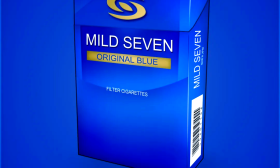Title: Clearing the Air: How Smoking Exacerbates Nocturnal Symptoms in Chronic Rhinitis
Chronic rhinitis, a persistent inflammation of the nasal mucous membranes, affects millions worldwide, causing a spectrum of debilitating symptoms such as nasal congestion, rhinorrhea (runny nose), sneezing, and postnasal drip. For many sufferers, these symptoms intensify at night, significantly disrupting sleep architecture and diminishing overall quality of life. While allergens, pollutants, and genetic predispositions are recognized contributors, one modifiable risk factor stands out for its profound aggravating effect: tobacco smoking. This article delves into the pathophysiological mechanisms through which smoking, both active and passive, markedly worsens the nocturnal manifestations of chronic rhinitis.

The Nighttime Agony of Chronic Rhinitis
Nocturnal symptoms present a unique challenge. The supine position assumed during sleep promotes blood redistribution, including to the nasal turbinates, leading to physiological nasal congestion. For individuals with chronic rhinitis, this baseline congestion is already heightened. The addition of inflammatory triggers can turn a minor inconvenience into a severe obstruction. Common nocturnal complaints include:
- Severe Nasal Congestion: Making nasal breathing nearly impossible, forcing mouth breathing.
- Postnasal Drip: The sensation of mucus draining down the throat, triggering persistent coughing, throat clearing, and even choking sensations that interrupt sleep.
- Dry Mouth and Sore Throat: Resulting from prolonged mouth breathing.
- Sleep Fragmentation: Frequent awakenings due to breathing difficulties or coughing, leading to non-restorative sleep and daytime fatigue.
Smoking as a Potent Inflammatory Insult
Tobacco smoke is a complex mixture of over 7,000 chemicals, hundreds of which are toxic and at least 70 known to cause cancer. When inhaled, this noxious cloud directly assaults the entire respiratory epithelium, including the nasal mucosa. Its impact on chronic rhinitis is multifaceted and severe.
1. Direct Irritation and Epithelial Damage:The first point of contact for smoke is the nasal lining. The heat and numerous irritant chemicals, such as acrolein and formaldehyde, cause immediate vasodilation (widening of blood vessels) in the nasal tissues. This directly translates to worsened congestion almost instantaneously. Furthermore, these toxins damage the cilia—the microscopic, hair-like structures on the surface of cells that rhythmically beat to sweep mucus and trapped particles toward the throat. Ciliary dysfunction leads to mucociliary clearance failure, causing mucus to stagnate, thicken, and accumulate, exacerbating both daytime and nighttime congestion and postnasal drip.
2. Exacerbation of Neurogenic Inflammation:Chronic rhinitis often involves neurogenic inflammation, where nerves in the nasal mucosa release neuropeptides like Substance P, causing vasodilation and plasma leakage. Tobacco smoke is a potent stimulator of this pathway. It activates sensory nerve endings (the trigeminal nerve), amplifying the release of these inflammatory neuropeptides. This results in increased vascular permeability, tissue swelling, and glandular secretion, directly fueling the symptoms of rhinorrhea and congestion that become so prominent at night.
3. Dysregulation of Immune Response:Smoking disrupts the normal immune function of the nasal mucosa. It promotes a pro-inflammatory state by:
- Activating Mast Cells: Key players in allergic responses, leading to increased release of histamine and other mediators that cause itching, sneezing, and secretion.
- Altering Cytokine Profiles: Smoking upregulates the production of inflammatory cytokines (e.g., IL-4, IL-8, TNF-α) while suppressing anti-inflammatory or regulatory cytokines. This creates a state of persistent, low-grade inflammation that primes the nasal passages to overreact to even minor triggers, such as dust mites in bedding or cool night air.
4. Impaired Nitric Oxide (NO) Metabolism:The paranasal sinuses produce nitric oxide, a gas with antiviral, antimicrobial, and vasodilatory properties that is thought to play a role in maintaining healthy respiratory function and patency. Studies have shown that smoking significantly reduces nasal NO levels. This impairment may weaken a natural defense mechanism, making the nasal passages more vulnerable to infection and inflammation, further complicating the rhinitis picture.
Why Nocturnal Symptoms Are Particularly Affected
The detrimental effects of smoking converge most critically during the night for several reasons:
- Accumulation of Irritants: Throughout the day, a smoker continuously exposes their nasal passages to irritants. While awake, mechanisms like frequent blowing of the nose or movement provide minor relief. During sleep, the body is static, allowing the accumulated inflammatory mediators, damaged cilia, and thickened mucus to exert their full effect unimpeded.
- Recumbency and Mucous Pooling: The supine position hinders drainage. With ciliary function already paralyzed by smoke, the mucus produced throughout the day and evening has no efficient way to clear. It pools in the nasopharynx, creating the relentless sensation of postnasal drip that triggers reflexive coughing and awakening.
- Environmental Co-Factors: Bedrooms often harbor common allergens like dust mites and pet dander. Smoking-induced hyperreactivity means the nasal mucosa will respond more violently to these allergens at night, creating a compounded inflammatory response.
- Circadian Rhythm of Inflammation: Some inflammatory mediators, such as cortisol, naturally fluctuate throughout the day. Cortisol, which has anti-inflammatory effects, is at its lowest during the night. This natural dip may unmask and intensify the inflammation driven by smoking, leading to a peak in symptom severity during sleep hours.
Secondhand Smoke: A Significant Threat
It is crucial to emphasize that the risk is not confined to active smokers. Secondhand smoke (SHS) exposure, especially in the home, is a major contributor. Children living with smokers show a significantly higher prevalence of rhinitis and other respiratory illnesses. For adults with chronic rhinitis, sharing a bed or a household with a smoker means continuous exposure to the same inflammatory irritants throughout the night, perpetuating the cycle of symptoms and sleep disruption.
Conclusion and Implication for Management
The evidence is unequivocal: smoking is a major exacerbating factor for chronic rhinitis, with a particularly pronounced impact on nocturnal symptoms. It transforms the night from a time of rest into a period of struggle for breath and uninterrupted sleep.
Therefore, the single most effective intervention for a smoker suffering from chronic rhinitis is smoking cessation. Quitting smoking allows for the gradual recovery of ciliary function, reduction in neurogenic inflammation, and normalization of the immune response in the nasal mucosa. While this process takes time, studies show significant improvement in nasal symptoms after cessation. For those exposed to secondhand smoke, implementing a strict smoke-free home and bedroom policy is equally critical.
Managing chronic rhinitis requires a multi-pronged approach involving intranasal corticosteroids, saline irrigation, and allergen avoidance. However, without addressing the monumental inflammatory burden of tobacco smoke, these measures are akin to bailing water out of a ship with a gaping hole. Plugging the hole—by eliminating smoke exposure—is the foundational step toward reclaiming restful nights and achieving lasting symptomatic control.











